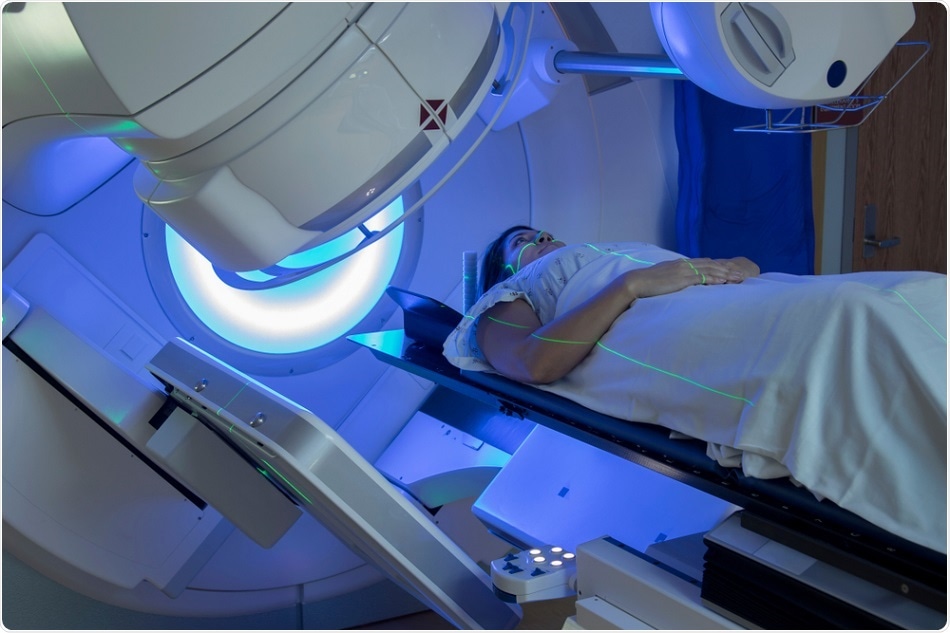Radiation therapy is a time-honored approach to destroying cancer cells that escape the knife, or which are not accessible for surgery. However, it has its risks and limitations. Now a new study, published in the journal Scientific Reports, indicates a promising new way to deliver locally aggressive radiation therapy in cancer, using the element gadolinium. When silica nanoparticles containing gadolinium are taken up by cancer cells and exposed to a monochromatic beam of radiation at the right energy, it is excited and releases low-energy electrons that cause lethal damage to the cancer cells.
 Mark_Kostich | Shutterstock
Mark_Kostich | Shutterstock
Overview of radiation therapy
Radiation therapy uses beams of high-energy electromagnetic waves to kill cancer cells. The most common type of radiation used comprises X-rays. However, protons and other energy sources are also used. Both external and internal sources of radiation are used, but radiation therapy usually refers to an external beam of radiation.
External radiation comes from an external source outside the body and may use multiple beams that are collimated or focused to act as selectively as possible on the tumor and immediately adjacent areas, while ensuring that the healthy cells are spared toxic doses of radiation. Internal radiation works from an implanted source of radiation, such as brachytherapy which uses radioactive seeds or wires inserted into or near the tumor.
Another source of internal radiation is a radioactive liquid that is carried by the blood to treat cancer cells that may have spread throughout the body. This makes the body fluids radioactive for some time. A new and extremely promising method of radiation therapy is targeted radionuclide therapy. This makes use of a radioactive particle combined with a molecule like an artificial antibody that selectively attaches only to the cancer cells. This is also called molecular radiotherapy.
Radiation is effective in cancer because it damages cell membranes and organelles, or cell components, of which the most sensitive is the nucleus which contains the DNA or genetic blueprint of the cell. Once the DNA is damaged irreparably, the cell is non-viable and dies, to be degraded and removed. However, to avoid unnecessary toxicity to healthy cells, radiation therapy avoids the use of very high-energy waves. Instead, cumulative damage is done to cancer cells by repeatedly exposing them to smaller doses of radiation. The DNA is hit again and again by harmful but sublethal doses of energy to add up to a lethal dose over weeks and months. This effect continues for variable periods, from weeks to months, after the end of treatment.
The body can tolerate only a limited amount of radiation because of the damage it causes. Thus, radiation therapy is typically not repeated to the same part of the body. However, it can be given to another part of the body, provided it is sufficiently far away from the first that the irradiated area does not share a common boundary with the first area.
Gadolinium excitation and radiation therapy
Gadolinium is known to be a radiosensitizer because it absorbs the energy of a beam of radiation and thus enhances the radiation-induced production of ionizing free radicals, which are harmful chemical groups that cause damage to living cells following exposure to radiation. Thus, these cells are more vulnerable than normal cells to the harmful effects of radiation. This allows either the dose of radiation to be reduced, thus increasing the safety margin, or increases the percentage of killed cells with the course of radiation therapy.
The property which makes gadolinium so useful in the current experiment is not radiosensitization, however. Instead, this element can release high-energy electrons when swept by a beam of high-frequency X-rays tuned to the right wavelength. In effect, the X-ray radiation increases the amount of X-radiation available at the site of the cancer.
This solves one of the major problems of current radiation therapies, where only a small amount of X-rays actually reach the tumor.”
Researcher Kotaro Matsumoto
Radiation therapy is based on the use of X-rays of diverse energy levels, but low energy waves cannot penetrate the surface of the body. X-rays that have a single energy level are called monochromatic, in contrast to the polychromatic nature of typical X-rays. The researchers sought to modify the situation by using monochromatic X-rays to strike special elements like gadolinium that respond to the radiation blow with a shower of tissue-toxic electrons. The electrons can fatally disable and kill tumor cells.
How the experiment was performed
To accomplish their goal, the scientists took custom-built silica nanoparticles into which gadolinium was incorporated, and incubated them with cancer cells in a 3D culture. The resulting tumor contained cells that took up the nanoparticles, which were located just outside the cell nucleus.
The researchers took samples of these tumors to a synchroton facility, the Spring-8 building in Harima, Japan. There the samples were subjected to monochromatic X-rays tuned to have the same energy level, that is, 50.25 kiloelectron volts (keV). The X-ray barrage continued for one hour.
They then awaited the results, keeping the tumor under observation. Within just two days, the cancer cells had all died. The gadolinium-loaded nanoparticles close to the nucleus emitted low-energy electrons that blasted the highly critical DNA of the cell, as well as fanning out through the cell. This led to the complete destruction of cell viability.
When the energy level was reduced, the effect was suboptimal. This is because the energy of the radiation that excites gadolinium to the point of releasing electrons is very specific. Similarly, simply irradiating cells that do not contain gadolinium-loaded nanoparticles failed to have any effect.
Our study demonstrates that a new type of radiation therapy for cancer can be developed. We can expect radiation therapy with increased efficacy and less side-effects.”
Researcher Fuyuhiko Tamanoi
Journal reference:
Kotaro Matsumoto et al. 'Destruction of tumor mass by gadolinium-loaded nanoparticles irradiated with monochromatic X-rays: Implications for the Auger therapy.' https://www.nature.com/articles/s41598-019-49978-1